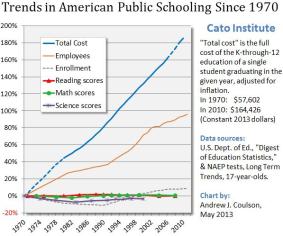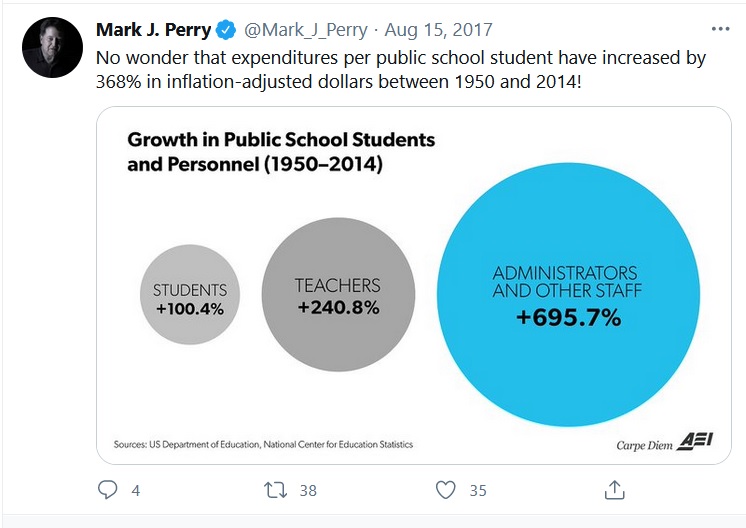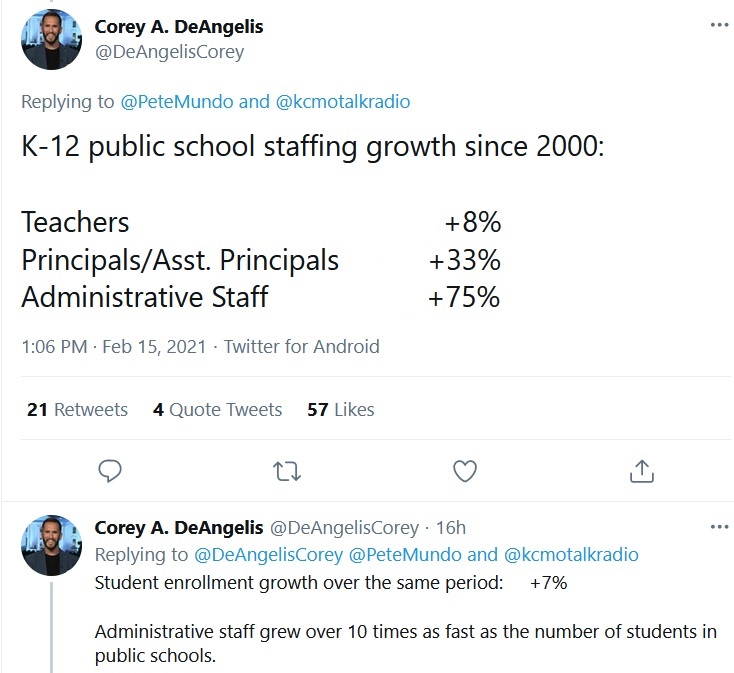Whenever I’m asked to give an example of a powerful and persuasive visual, I always have an easy answer.
 The late Andrew Coulson created a very compelling chart showing that huge increases in money and staff for government schools have not led to improvements in educational outcomes.
The late Andrew Coulson created a very compelling chart showing that huge increases in money and staff for government schools have not led to improvements in educational outcomes.
All rational people who look at that image surely will understand that we’re doing something wrong.
And if they review the academic evidence on government spending and educational results, they’ll definitely know we’re doing something wrong.
The international data, by the way, tells the same story. Which is especially disheartening since Americans taxpayers spend much more on education than their counterparts in other developed nations.
Let’s further investigate this issue.
 I came across a 2017 tweet from Mark Perry that gives us another way of looking at the numbers.
I came across a 2017 tweet from Mark Perry that gives us another way of looking at the numbers.
He reviewed 64 years of data and found that government spending on education soared by 368 percent. And that’s after adjusting for inflation.
We got more teachers with all that money, but the main outcome was a massive expansion in the number of education administrators and other bureaucrats.
In other words, most of the additional money isn’t being used for classroom instruction.
And the numbers seems to get worse every year. In a recent article for Education Next, Ira Stoll uses two different data sets to document the growth of bureaucracy.
Here is some of the data he got from the Department of Labor.
Are schools really spending more on administration than they used to? The short answer is yes. …information to corroborate the idea of skyrocketing administrative spending may be obtained from a different source: the U.S. Bureau of Labor Statistics.
…The category of “education administrators, kindergarten through secondary” in May 2019 included 271,020 people earning a mean annual wage of $100,340. In 1999, there were 186,220 people in this category, earning a mean annual wage of $65,480. That is 45.5 percent growth in the number of administrators. …The math works out to nearly three $100,000-a-year administrators for every school.
Here’s his table based on numbers from the Department of Education.
In each case, we see bureaucrats have been the biggest winners. There are a lot more of them than there used to be, and they enjoy lavish compensation packages.
Cory DeAngelis of Reason summarized Stoll’s findings in a pair of tweets.
Frederick Hess of the American Enterprise Institute explains that all this additional funding and additional bureaucracy is not yielding worthwhile results.
…the U.S. spends more than $700 billion on K–12 education a year, or about $14,000 per student. That’s 39 percent more than the average OECD nation. And many big-city districts spend considerably more,
with per-pupil outlays of more than $20,000 per year in places such as Washington, D.C., and Boston. …But it’s not clear that we’re spending all of this money in effective ways. For instance, …the ranks of non-instructional staff have grown more than twice as fast as student enrollment over the past 30 years. …in public bureaucracies, new dollars often double as a convenient excuse to avoid hard choices.
So what’s the moral of the story?
I don’t need to write anything because this article in National Review by Cameron Hilditch has a very apt summary.
American taxpayers have been hoodwinked by the whole idea of “public schools.” …We’ve been putting more and more money into the system for decades without reaping more returns for the nation’s children. …schools are advertised to taxpayers as institutions that serve every child in the nation.
In reality, they serve the interests of no one other than the small group of Americans who work in these schools as teachers and administrators. …Since the teachers unions can shield their own avarice with claims of “public service” to children, they can manipulate the actual public into thinking that more money, job security, or political power for themselves is in everyone’s interest instead of their own. …a look at graduation rates, test scores, and graduate employability calls this into question.
P.S. While this column has mostly focused on the ever-expanding number of administrators and other education bureaucrats, as well as their lavish salaries, it’s worth noting that compensation for teachers also has been going up.
P.P.S. Though the real problem is not teacher pay. Some deserve more pay, some deserve less pay, and some deserve to be fired, but we can’t separate the wheat from the chaff because teacher unions and local politicians have created an inefficient system that delivers mediocrity.
P.P.P.S. We need school choice so that competitive pressure rewards the best teachers as part of a system that focuses on better results for students.


[…] government school systems cost a lot of moneyand do a bad job.The interests of the education bureaucracy rank higherthan the […]
[…] government school systems cost a lot of moneyand do a bad job.The interests of the education bureaucracy rank higherthan the […]
[…] government school systems cost a lot of moneyand do a bad job.The interests of the education bureaucracy rank higherthan the […]
[…] government school systems cost a lot of moneyand do a bad job.The interests of the education bureaucracy rank higherthan the […]
[…] main argument for choice is that government schools squander record amounts of money and deliver very poor results. Especially for disadvantaged students. But there […]
[…] government school systems cost a lot of moneyand do a bad job.The interests of the education bureaucracy rank higherthan the […]
[…] government school systems cost a lot of moneyand do a bad job.The interests of the education bureaucracy rank higherthan the […]
[…] right that government schools obviously are incapable of doing the […]
[…] government school systems cost a lot of moneyand do a bad job.The interests of the education bureaucracy rank higherthan the […]
[…] those who care about empirical data, the evidence is overwhelming that you do not get better educational outcomesby dumping more taxpayer dollars into government […]
[…] right that government schools obviously are incapable of doing the […]
[…] those who care about empirical data, the evidence is overwhelming that you do not get better educational outcomes by dumping more taxpayer dollars into government […]
[…] right that government schools obviously are incapable of doing the […]
[…] government school systems cost a lot of moneyand do a bad job.The interests of the education bureaucracy rank higherthan the […]
[…] government school systems cost a lot of moneyand do a bad job.The interests of the education bureaucracy rank higherthan the […]
[…] government school systems cost a lot of moneyand do a bad job.The interests of the education bureaucracy rank higherthan the […]
[…] government school systems cost a lot of moneyand do a bad job.The interests of the education bureaucracy rank higherthan the […]
[…] government school systems cost a lot of moneyand do a bad job.The interests of the education bureaucracy rank higherthan the […]
[…] government school systems cost a lot of moneyand do a bad job.The interests of the education bureaucracy rank higherthan the […]
[…] government school systems cost a lot of moneyand do a bad job.The interests of the education bureaucracy rank higherthan the […]
[…] government school systems cost a lot of moneyand do a bad job.The interests of the education bureaucracy rank higherthan the […]
[…] government school systems cost a lot of moneyand do a bad job.The interests of the education bureaucracy rank higherthan the […]
[…] government school systems cost a lot of moneyand do a bad job.The interests of the education bureaucracy rank higherthan the […]
[…] government school systems cost a lot of moneyand do a bad job.The interests of the education bureaucracy rank higherthan the […]
[…] government school systems cost a lot of moneyand do a bad job.The interests of the education bureaucracy rank higherthan the […]
[…] government school systems cost a lot of moneyand do a bad job.The interests of the education bureaucracy rank higherthan the […]
[…] government school systems cost a lot of moneyand do a bad job.The interests of the education bureaucracy rank higherthan the […]
[…] government school systems cost a lot of moneyand do a bad job.The interests of the education bureaucracy rank higherthan the […]
[…] government school systems cost a lot of moneyand do a bad job.The interests of the education bureaucracy rank higherthan the […]
[…] government school systems cost a lot of moneyand do a bad job.The interests of the education bureaucracy rank higherthan the […]
[…] government school systems cost a lot of moneyand do a bad job.The interests of the education bureaucracy rank higherthan the […]
[…] government school systems cost a lot of moneyand do a bad job.The interests of the education bureaucracy rank higherthan the […]
[…] government school systems cost a lot of moneyand do a bad job.The interests of the education bureaucracy rank higherthan the […]
[…] failing because big government is bad government (the same lesson we learn when looking at more government and lousy results in the United […]
[…] government school systems cost a lot of moneyand do a bad job.The interests of the education bureaucracy rank higherthan the […]
[…] government school systems cost a lot of moneyand do a bad job.The interests of the education bureaucracy rank higherthan the […]
[…] government school systems cost a lot of moneyand do a bad job.The interests of the education bureaucracy rank higherthan the […]
[…] government school systems cost a lot of moneyand do a bad job.The interests of the education bureaucracy rank higherthan the […]
[…] We can continue to pour more money into monopoly, government-run systems that never produce better results. […]
[…] government school systems cost a lot of moneyand do a bad job.The interests of the education bureaucracy rank higherthan the […]
[…] government school systems cost a lot of moneyand do a bad job.The interests of the education bureaucracy rank higherthan the […]
[…] thing that became very apparent during the pandemic is that government schools are mostly run for the benefit of bureaucrats rather than […]
[…] thing that became very apparent during the pandemic is that government schools are mostly run for the benefit of bureaucrats rather than […]
[…] government school systems cost a lot of moneyand do a bad job.The interests of the education bureaucracy rank higherthan the […]
[…] other words, all of these slots are sad examples of the self-serving bureaucuratization of government […]
[…] other words, all of these slots are sad examples of the self-serving bureaucuratization of government […]
[…] government school systems cost a lot of moneyand do a bad job.The interests of the education bureaucracy rank higherthan the […]
[…] I’m debating the quality of government schools or the funding of government schools, I routinely share this chart from the late Andrew […]
[…] We can continue to pour more money into monopoly, government-run systems that never produce better results. […]
[…] government school systems cost a lot of moneyand do a bad job.The interests of the education bureaucracy rank higherthan the […]
[…] government school systems cost a lot of moneyand do a bad job.The interests of the education bureaucracy rank higherthan the […]
[…] you’re wondering why I have that view, just click here, here, here, here, […]
[…] you’re wondering why I have that view, just click here, here, here, here, and […]
[…] Second, it’s not voucher proponents that have been “steadily working to undermine public education.” Instead, the NEA should look in the mirror. It’s the union bosses and their political allies who have made government schools less attractive. They’ve been given record amounts of money and produced dismal educational outcomes. […]
[…] another layer of costly bureaucracy. At worst, it led to mandates and regulations that exacerbated the problem of ever-more spending for ever-weaker […]
[…] We can continue to pour more money into monopoly, government-run systems that never produce better results. […]
[…] We can continue to pour more money into monopoly, government-run systems that never produce better results. […]
[…] part of that column, I mentioned that “government school systems cost a lot of money and do a bad […]
[…] government school systems cost a lot of moneyand do a bad job.The interests of the education bureaucracy rank higherthan the […]
[…] government school systems cost a lot of money and do a bad job. The interests of the education bureaucracy rank higher than the educational needs […]
[…] bottom line is that government transit systems are a lot like government schools. More and more money gets spent over time with worse and worse […]
[…] bottom line is that government transit systems are a lot like government schools. More and more money gets spent over time with worse and worse […]
[…] of us should be upset that we see more and more moneygoing to more and more employees, but we don’t get any progress in boosting academic […]
[…] of us should be upset that we see more and more money going to more and more employees, but we don’t get any progress in boosting academic […]
[…] bottom line is that government transit systems are a lot like government schools. More and more money gets spent over time with worse and worse […]
[…] bottom line is that government transit systems are a lot like government schools. More and more money gets spent over time with worse and worse […]
[…] There’s a lot of research showing better educational outcomes when families have options other than low-performing, monopoly-based government schools. […]
[…] There’s a lot of research showing better educational outcomes when families have options other than low-performing, monopoly-based government schools. […]
[…] schools are doing a poor job of educating children. Especially considering the record amounts of money that’s being dumped into the […]
[…] unions, government schools are doing a poor job of educating children. Especially considering the record amounts of money that’s being dumped into the […]
[…] would be good for kids and it would be good for taxpayers (we’re spending record amounts of money on the failed government school monopoly, so turning that money into vouchers would provide […]
[…] would be good for kids and it would be good for taxpayers (we’re spending record amounts of money on the failed government school monopoly, so turning that money into vouchers would provide enough […]
Posted on Gab. Hope that is okay….
Excellent article. I saved it to Pocket to use as a reference for future discussions with the “But it’s for the kids” supporters.
Reblogged this on boudica.us.
Reblogged this on Freedom Is Just Another Word….
You could write a similar piece on welfare and medical spending. The US spends more per capita on welfare and medical than many other developed countries and gets less than what is supplied by other countries. The federal government spends about $3692 per person (when averaged over the entire US population) but can’t give the same quality of care as Iceland that spends $3646. At this stage of the game the question isn’t why can’t the US provide mostly free health care to its citizens but rather why it isn’t if it is already paying for it?